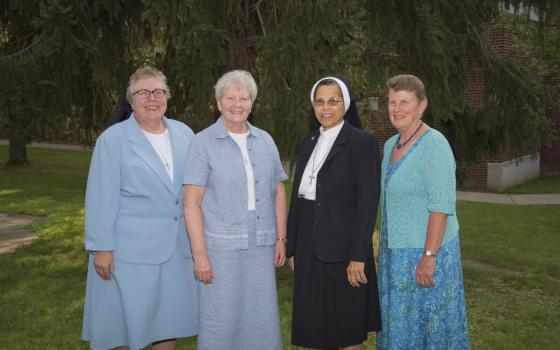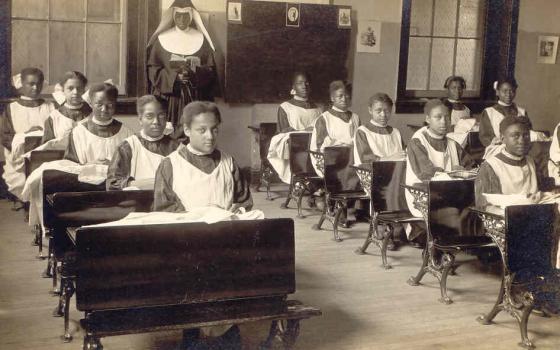In July, just three months after Baltimore was ablaze following yet another police-related death of an unarmed black man in the United States, the Oblate Sisters of Providence traveled from their Baltimore motherhouse to Scranton, Pennsylvania, to dive into some race work of their own.
The sisters' presence in Scranton at the decennial meeting of the Oblate Sisters and the Sisters of the Immaculate Heart of Mary — their third appearance — was an act of racial reconciliation in and of itself. The meeting is a time for the congregations to celebrate their shared history and to update each other on their lives and ministries. But until 1995, the joint meeting had been only for the three (mostly white) communities of the Redemptorist Fr. Louis Florent Gillet's spiritual daughters: the Sisters, Servants of the Immaculate Heart of Mary congregations in Scranton; in Immaculata, Pennsylvania; and in Monroe, Michigan.
The Oblates — the first congregation of black women religious in the United States — weren't invited until the Immaculate Heart of Mary congregations first began to openly acknowledge that they and the Oblate sisters had a shared biracial co-founder in Theresa Maxis Duchemin.
For more than 160 years, that fact had been kept closely under wraps by leadership in the Immaculate Heart of Mary communities who did not want to be associated with a black sister. It was "embarrassing" and "unpleasant," as sisters wrote in various letters. It would scare white people away from their ministries. And so Duchemin was scrubbed from Immaculate Heart of Mary history. According to Sr. Margaret Gannon, a historian and Immaculate Heart of Mary sister from Scranton, before the 1980s, novices didn't even learn about Duchemin in formation.
But when Gannon began writing about Duchemin — and by extension, the Oblate Sisters of Providence — in the 1970s, there was mounting pressure to accept Duchemin as a co-founder of the Immaculate Heart of Mary communities along with Fr. Gillet. Then in 1992, Gannon published a collection of letters to, from and about Duchemin that not only solidified her status as an Immaculate Heart of Mary co-founder, but also showed the extensive efforts taken to keep that status a secret for generations.
There, in black and white, were more than 50 years of Immaculate Heart of Mary leadership explicitly forbidding historians from including Duchemin's background in their works. At one point, they even enlisted a cardinal to intervene in the publication of a book that might have outed them as having been co-founded by a black woman.
Gannon's book was a game changer, and three years later, an invitation was extended to the Oblate leadership to join the Immaculate Heart of Mary sisters for their celebration, which was held in Monroe that year. About four or five administrators from Baltimore showed up, recalls Sr. Rosemary Davis, an Immaculate Heart of Mary sister from Immaculata. The Oblates arrived during lunch, and when they entered the dining hall, the Immaculate Heart of Mary sisters rose to their feet and cheered.
It was very moving, Davis says, but as she and many others would soon find out, the real work of racial reconciliation, the hard work, was still forthcoming.
Not every Immaculate Heart of Mary sister was happy about the inclusion of the Oblates, and not every Oblate sister wanted to celebrate Duchemin. After all, she had abandoned the Oblate Sisters of Providence and moved nearly 500 miles away to Monroe to found the new Immaculate Heart of Mary congregation. Many viewed her as a traitor.
In 2001, the four congregations started the Healing Racism Committee to help sisters talk through big issues like institutional racism. Two years later, the committee hosted the first of what would become a biennial summer workshop at the Oblate sisters' motherhouse in Baltimore, that year focusing on addressing racism on the individual, congregational, national and global levels.
"The process of healing, that could only be done by facing our past," said Davis, an inaugural member of the Healing Racism Committee, "by admitting the hurts and wrongs and then trying to work toward healing."
And that's still the mission today. Case in point: Before the Scranton meeting in July, selected preconference readings included texts from the Southern Poverty Law Center and Christian Peacemaker Teams on white privilege.
Because even now, 14 years after the intercongregational conversations began, not everyone gets it.
"It's really hard to get people to own this," said Sr. Joyce Bell, an Immaculate Heart of Mary sister from Immaculata and a current member of the Healing Racism Committee. "Unless they go through a personal conversion to accept the fact that being white has placed us in a place different from where a person of color is, even if they're doing a ministry with marginalized groups, they may not understand the ramifications."
Sr. Lauretta Linsalata, also an Immaculate Heart of Mary sister from Immaculata and a member of the Healing Racism Committee, concurred, saying it can sometimes be difficult to get white sisters interested in even going to the racism workshops. The apathy isn't universal, she said, but it's there.
"It's really unconscious racism because they don't realize," Linsalata said. "But you just have to look at the news to see what's going on in the world. And since we are a microcosm of the world, things like this do creep up."
Oblate Sr. Marcia Hall, on the other hand, says her community is well-versed in the effects of racism — conscious or otherwise. She didn't need to print out the preconference texts on white privilege for the sisters in her community. "I think they understand what that means without having to read an article about that," she said with a chuckle.
The first U.S.-born black Catholic sister
To understand the Oblate sisters' relationship with white America and the white Catholic church, you have to start in 19th-century Baltimore, which then had a significant Haitian population — the descendants of former slaves who had been brought to the United States by white owners fleeing the violence of the Haitian Revolution that began in 1793.
In 1829, wanting to teach Baltimore's black girls to read, Sulpician Fr. James Joubert and four women of Caribbean descent — Elizabeth Lange, Marie Magdalene Balas, Marie Rose Boegue, and Theresa Maxis Duchemin — founded the Oblate Sisters of Providence and opened the Oblate School for Colored Girls.
The blond-haired, light-complexioned Duchemin (she was the daughter of a Haitian refugee and a British military officer, the latter of which was likely not aware of her existence) was the first U.S.-born black woman to become a Catholic sister.
For 14 years, the Oblate sisters taught Baltimore's black children. But when Joubert died, with him died most of the diocesan support for the Oblate sisters and their schools. "Less sympathetic" church leaders, as Gannon would later describe them, had waning interest in supporting the black order or their ministries.
Duchemin, who had moved into Oblate leadership and was now known as Mother Theresa, tried to save the sisters' ministries. But when Fr. Louis Gillet approached the bilingual Mother Theresa about founding a new community in the French-English speaking community outside of Detroit, she decided to leave Baltimore and the Oblate sisters.
Arriving in Monroe in 1845, Mother Theresa soon dropped the Duchemin — her mother's Haitian family name — from her legal identity and began living as a white woman named Theresa Maxis. It's clear, however, that the priests and bishops she interacted with in the Detroit diocese were aware that she, as one bishop would later put it, "had a strain of Negro blood" in her veins.
In 1858, Mother Theresa started a mission in Pennsylvania's Choconut Valley, which would ultimately become the Immaculate Heart of Mary Scranton congregation. But it was a heated argument the following year with Michigan church leaders about a second mission in Reading, Pennsylvania, that the Detroit bishop opposed (according to letters between the bishop, Mother Theresa and local church leadership) that would get Mother Theresa kicked out of both the Immaculate Heart of Mary congregation in Monroe as well as the Detroit diocese. She would go on to open the Reading mission anyway, and that mission ultimately became the Immaculate Heart of Mary congregation in Immaculata.
However, Mother Theresa didn't arrive in Reading without conflict. In an 1859 letter to the church leadership in Pennsylvania, the Detroit bishop wrote of her and another sister who went with her into exile from Monroe:
"If you take the pains to go & see that Mother Theresa & Sister Ann, & converse with them a little, you will soon discover in them, notwithstanding their advanced age, all the softness, slyness & low cunning of the mulatto & surely the colored Sisters in Baltimore will rejoice at hearing that one of their body is at the head of such an establishment as that at Reading."
Before long, Mother Theresa would be exiled from her Pennsylvania congregations as well — this time inexplicably, but again by local bishops. She wouldn't live with Immaculate Heart of Mary Sisters again until the last seven years of her life. Before she died, however, she opened up for the first time about her past life with the Oblate Sisters of Providence, and as soon as a month after her death in 1892, Fr. F.X. Schnüttgen, a Redemptorist priest Mother Theresa had befriended in her exile, wrote that he was afraid the Immaculate Heart of Mary congregations would try to disassociate themselves from her because of her race.
He was right.
Efforts to publish Mother Theresa's biography were thwarted, and in 1893, Schnüttgen lamented, "It is strange that color should cause Religious to have a prejudice against a very deserving person. The Spouse in the Canticles is called 'Nigra sed Formosa', black but beautiful. I fear that some of the white opponents of good Mother Teresa are in reality more black [in soul] than the one they disown as their Mother."
Meanwhile, the Oblate sisters hadn't shuttered, as Mother Theresa had feared when she left for Monroe. In fact, they thrived under new Redemptorist leadership starting in 1847 — two years after Mother Theresa's departure. The sisters opened a second school, this time for black boys, in 1852. In the 1860s, the accepted mission assignments in New Orleans and Philadelphia, and in the 1880s, they accepted assignments in Kansas and Missouri. In 1960, they moved their motherhouse to a 46-acre property just outside of Baltimore.
'The problem of the 21st century'
At the same time that Immaculate Heart of Mary leadership were making marked and deliberate moves to hide Mother Theresa's Haitian roots and to erase evidence of her influence on their communities, some young would-be black sisters were being discouraged from religious life.
An Oblate associate who did not wish to be named said when she was young, she really wanted to be a Catholic sister. But when she asked one of her teachers, a white Catholic sister, about religious life, she was given a litany of reasons for why she couldn't pursue a vocation: The convent didn't accept people from her part of town, her parents were converts, so on and so forth.
She said she knows now that the real reason was because she was black. If she had known about the Oblate sisters at the time, she said, she would have joined. Instead, she gave up on her dream of religious life.
Sr. Marcia Hall said many of the older sisters in the Oblate community have tales about the abuses they suffered in the church when they were growing up.
"Our sisters will talk about having to receive Communion last in some places, about having to sit in the back of the church in some places, about priests flatly telling them they would not give them Communion," she said.
Things have changed in the United States, but they aren't fixed, said Hall, a former member of the Immaculate Heart of Mary/Oblate sisters’ Racial Healing Committee.
"We know from what's going on that race is still the problem," she said. "As [W.E.B.] Du Bois said it was the problem of the 20th century — well, it's still the problem of the 21st century." The riots in Baltimore following the death of Freddie Gray, for example, she said, weren't just about Freddie Gray.
"Freddie Gray was the tipping point," she said, "but Baltimore has a history — like many American cities — of segregation. So you've got severe housing segregation. You've got rotten public schools. We've got a history of police brutality. Freddie Gray was the match that set all that off."
The Oblate sisters responded to Gray's death and the subsequent protests by simply being present, Hall said.
"Sometimes that means listening to somebody, hearing what someone has to say," she said. "Sometimes someone has a complaint, and they feel like no one has paid them any mind. So it means hearing out those people, and it may not always be pleasant to hear what they have to say."
Hall has made it a point to stop and pray for anyone who asks for prayer, even if she's in the middle of the grocery store.
Preparations for the Scranton meeting this summer kept the Healing Racism Committee from its regular biennial meeting schedule, so it has yet to discuss the rash of high-profile police violence that followed the death of Michael Brown in Ferguson, Missouri, last year — which is not to say that individual members aren't thinking about it. The committee's focus right now is on connecting racial justice to creation care and Pope Francis' Laudato Sí, Linsalata said. She's sure, however, the police violence will come up when committee members meet in November.
Until then, the Healing Racism Committee wants to keep dialogue open, hoping to change hearts one by one.
"The biggest struggle for me is to try and get people who want to do something to make life better for other people," said Immaculate Heart of Mary Sr. Joyce Bell. "And it's hard when you're enjoying a peaceful, moderate, OK life to step out of that and put yourself where somebody else is — where every day is a struggle just to survive. But that's what's out there."
Linsalata said it's slow-moving, often frustrating work to talk about race in predominantly white settings, but she's optimistic.
"Sometimes I think we're not making inroads," she said. "But I think some of these things are sticking. And it makes us more conscious. And I think the more conscious we are, it carries over into all the people we meet and the people we work within all our different ministries."
[Dawn Cherie Araujo is staff reporter for Global Sisters Report based in Kansas City, Missouri. Follow her on Twitter @Dawn_Cherie.]
Related column from Immaculate Heart of Mary Sr. Nancy Sylvester, who was at the July meeting: Taking a long loving look at authentic religious life






